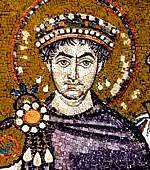Mystery Solved ("Incredibles Epigraphy")
I made an earlier post on this subject: the mystery of why the home of Edith Head in The Incredibles
 was decorated with what appeared to be an epigraphic inscription in very archaic Greek characters, reading "GLUQOS".
was decorated with what appeared to be an epigraphic inscription in very archaic Greek characters, reading "GLUQOS".I have mentioned earlier that since starting this blog I discovered the fantastically fun and useful site TextKit, and the equally useful and fun community of Classics Geeks in their forum. I wish I had known about this site sooner: ever since I stopped taking Greek and Latin at the Harvard Extension School (after almost three years, it was starting to get expensive), I've been reading on my own. And although one can generally correct one's own translations simply by consulting an existing English translation, there are times - especially in Greek - where the meaning is so obscure, and the text so inscrutible, that you want to know why it means what it does. Indeed, I have noticed more than one occasion where different translators gave notably different interpretations to a very difficult line of text, presumably because it is difficult (and possibly even corrupt) and therefore even very experienced scholars may not agree on the "correct" meaning. Anyway. Having a community to bounce such ideas off is a very nice thing indeed.
I've been meaning to ask the folks over at TextKit what they thought of the illustration in the Incredibles, and they came through without hesitation. It turns out that this topic has been discussed before, in some classics mailing list, and the illustration has been identified as from a "now lost Chalcidian vase depicting Ajax fighting off a Trojan attempt to capture the corpse of Achilles."
Greek learning texts from the 19th and early 20th century had a habit of including etchings or line-drawing illustrations of various Greek and Roman vases, sculptures, frescoes, and other artwork, and indeed a drawing from this particular vase appears on page 22 of this book:
 | Homeric Greek: A Book for Beginners Clyde Pharr and Wright $29.95 (No discount) |
where it is made clear that "GLUQOS" does refer to "Glaucos" - and that's clearly where I first saw it and why I found it so recognizable when I saw the movie. (Pharr was, by the way, my first Greek textbook at the Extension School. It's a book which some people love, but which most students tend to hate. It's certainly not for the faint-hearted. But there is something truly magical about learning Greek first through Homer, and indeed the uncontracted Ionic forms are much easier to learn than the standard Attic contractions - though the Aeolic forms do tend to complicate matters quite a bit, especially with pronouns.)
I say the mystery is "solved", but in fact the person I quoted above from the mailing list goes on to ask:
Can anyone on the list venture a guess as to how or why it got there (besides the obvious observation that the film is about heroism)?
And, in fact, that little part of the mystery is still as unsolved as ever, except that, as I mentioned in my earlier posting, the artist in question has a Greek last name. Nonetheless, I am glad that I am not the only person who noticed it, and even gladder that I'm not the only person to think it worthy of discussion.
Especial thanks to William Annis, author of the delightful site Aoidoi.org, for pointing me to the answer.
Categories: movies, incredibles, reviews, animation, fun, greek, koppa, language, epigraphy, paleography, classics, classical, language, homer, harvard, byjjmg














1 Comments:
Cool! I wondered at that when I saw it, but it flashed by too quickly. Thanks!
Post a Comment
<< Home